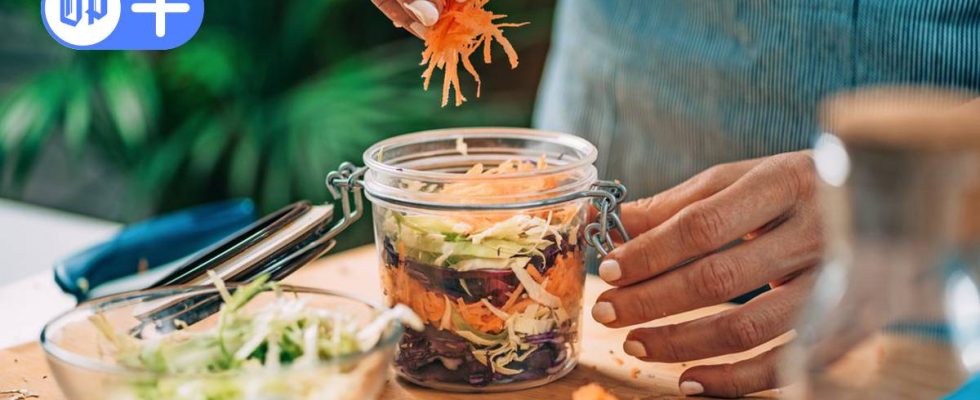Marburg. Fermented foods are trending. Kimchi, kombucha and good old sauerkraut are currently experiencing a real hype on the Internet and on various channels on Instagram and the like. The millennia-old craft of preserving food was rediscovered by star chefs a few years ago, and now it is once again finding its way into everyday cooking. And not without reason: during fermentation, vegetables, fruits, legumes, grains and dairy products are preserved without the use of intense heat. This means that vitamins, minerals and secondary plant substances are preserved with all their positive effects. The ferment also produces lactic acid bacteria (probiotics), which have a positive influence on the intestinal flora and the immune system.
Read more after the ad
Read more after the ad
But how exactly does it actually work at home in your own kitchen? “Fermentation is not difficult at all,” says someone who is familiar with it. Benjamin Nichell from Marburg is a nutritionist, lives vegan and has acquired his knowledge of fermentation through reading and trying things out. The 27-year-old passes this knowledge on to others in courses at the adult education center in Marburg, for example. “I always say that if you do the fermentation together, you have fewer failed attempts,” reports Nichell and laughs.
Fermentation releases vitamins
But before you start preparing and producing it, you first have to know what basically happens when the food is fermented. The original idea behind making sauerkraut in Germany or kimchi in Korea was to provide yourself and your family with enough vitamins during the winter months. “People have been using microorganisms to preserve food for thousands of years,” says Benjamin Nichell, showing various jars: kimchi, yoghurt, sourdough, kombucha – all of which are created through fermentation.
Read more after the ad
Read more after the ad
According to the Federal Center for Nutrition, this method has its origins in the Orient. First, various microorganisms consume the oxygen, so that lactic acid bacteria multiply and carbohydrates, i.e. sugar, can ferment into lactic acid. In an acidic environment, other germs grow more poorly, so the food lasts longer.
Cleanliness is important for fermentation processes
“Fermenting foods also creates completely new and different flavor nuances,” emphasizes Nichell. If you want to ferment food in your own kitchen, the nutritionist recommends paying attention to hygiene. “Cleanliness is very important when fermenting, otherwise the processes won’t work,” he explains. You need a large, sharp knife and a cutting board to chop the vegetables into small pieces. Then glasses are needed – simple screw-top jars are sufficient, preserving jars or clay pots also work. “The jars should be washed with hot water and boiled before filling,” advises Nichell. Then add the vegetables and salt – there are 20 grams of salt for every kilogram of vegetables. Everything is mixed well and mashed. “As a result of mixing, kneading and pounding, the cells burst open and liquid escapes,” explains the fermentation expert. At the end, the glasses are filled with water until the vegetables are completely covered. Then the glass is screwed together. “Now comes the most important thing: patience,” says Nichell: “Because fermentation is a process that takes time – three to four weeks for sauerkraut, kimchi can be ready after just a week, depending on how sour you like the taste wants.”
Around a third of the foods available in our supermarkets are fermented – for example sourdough bread, vinegar, Camembert, yoghurt and kefir. During targeted fermentation, they develop a unique taste and become more digestible. When making sauerkraut, the flatulent effect of cabbage largely disappears. The body is supplied with more and different nutrients because the food is not heated.
Benjamin Nichell from Marburg is a nutritionist and expert in fermenting foods.
© Source: Katharina Kaufmann-Hirsch
If you want to make your own yogurt, sourdough or kombucha, you need a starter culture. “In contrast to fermented vegetables, these foods require existing lactic acid bacteria or fungi to start the fermentation,” says Nichell, describing the difference. The bacteria or fungi then have to be “fed”, the scoby mushroom for the kombucha with sugar and black tea. “When someone asks me if I have pets, I always say: Yes, they all live in jars,” reports the 27-year-old, pointing to the shelf with a laugh. His courses are in demand and always book up quickly. This also shows that fermented foods are trendy.
Read more after the ad
Read more after the ad
also read
For the course “Fermentation – preserving without electricity. In cooperation with “Food Sharing Marburg” at the Marburg adult education center on November 19th, there are still a few places available. Further information at https://www.vhs-marburg.de
OP

